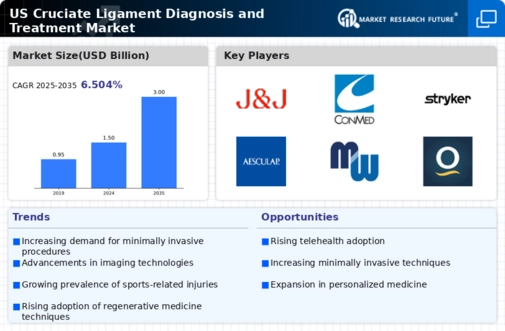Market Growth Projections
The Global US Cruciate Ligament Diagnosis and Treatment Market Industry is projected to experience substantial growth in the coming years. With an estimated market value of 3500 USD Million in 2024, it is expected to reach 5200 USD Million by 2035, reflecting a compound annual growth rate (CAGR) of 3.66% from 2025 to 2035. This growth trajectory underscores the increasing demand for effective diagnosis and treatment options for ACL injuries, driven by factors such as rising injury rates, advancements in technology, and heightened awareness of sports medicine.
Rising Incidence of ACL Injuries
The increasing prevalence of anterior cruciate ligament (ACL) injuries, particularly among athletes and active individuals, drives the Global US Cruciate Ligament Diagnosis and Treatment Market Industry. Statistics indicate that approximately 200,000 ACL injuries occur annually in the United States alone, with a significant number requiring surgical intervention. This trend is expected to contribute to the market's growth, as more individuals seek effective diagnostic and treatment options. The projected market value of 3500 USD Million in 2024 reflects this rising demand, highlighting the need for advanced diagnostic tools and innovative treatment methodologies to address ACL injuries.
Growing Awareness of Sports Medicine
The rising awareness of sports medicine and its role in injury prevention and rehabilitation significantly influences the Global US Cruciate Ligament Diagnosis and Treatment Market Industry. As more athletes and recreational sports participants recognize the importance of proper diagnosis and treatment of ACL injuries, the demand for specialized care increases. Educational initiatives and outreach programs by healthcare professionals contribute to this awareness, leading to a greater emphasis on preventive measures and timely interventions. This trend is likely to sustain the market's growth trajectory, with a projected CAGR of 3.66% from 2025 to 2035, reflecting the increasing prioritization of sports health.
Advancements in Diagnostic Technologies
Technological innovations in diagnostic imaging, such as MRI and ultrasound, enhance the accuracy of ACL injury assessments, thereby propelling the Global US Cruciate Ligament Diagnosis and Treatment Market Industry. These advancements allow for earlier detection and more precise evaluations of ligament damage, which can lead to improved treatment outcomes. As healthcare providers increasingly adopt these technologies, the market is likely to expand. The anticipated growth from 3500 USD Million in 2024 to 5200 USD Million by 2035 suggests a robust demand for sophisticated diagnostic solutions that can facilitate timely and effective interventions for ACL injuries.
Emerging Trends in Minimally Invasive Procedures
The shift towards minimally invasive surgical techniques for ACL reconstruction is reshaping the Global US Cruciate Ligament Diagnosis and Treatment Market Industry. These procedures offer numerous advantages, including reduced recovery times, less postoperative pain, and lower complication rates compared to traditional open surgeries. As more surgeons adopt these techniques, patient satisfaction and outcomes improve, driving demand for innovative surgical solutions. This trend aligns with the overall market growth, as the industry adapts to evolving patient preferences and technological advancements.
Increased Investment in Healthcare Infrastructure
The expansion of healthcare infrastructure, particularly in orthopedic and sports medicine facilities, plays a crucial role in the Global US Cruciate Ligament Diagnosis and Treatment Market Industry. Enhanced access to specialized clinics and advanced treatment options fosters a conducive environment for effective ACL injury management. Government initiatives aimed at improving healthcare access and quality further support this growth. As the market evolves, the anticipated increase in healthcare spending is expected to facilitate the development of state-of-the-art facilities and technologies, ultimately benefiting patients and healthcare providers alike.






















Leave a Comment